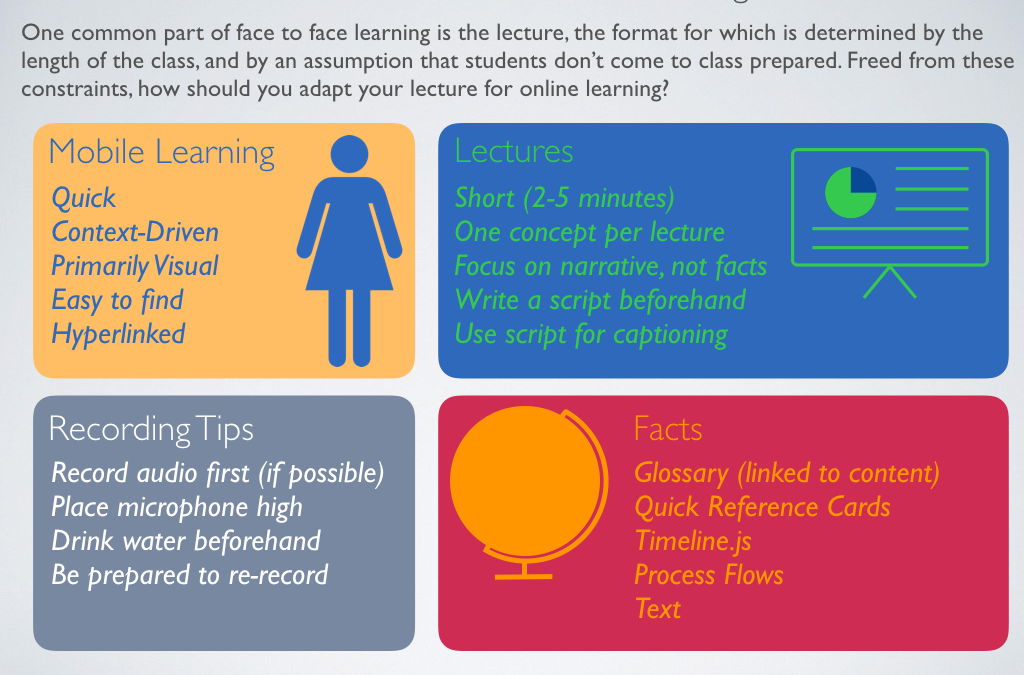When you think about adapting your course for online delivery, one of the first things you probably think about doing (or dread, depending), is retooling your powerpoint presentations as narrated lectures. I say this because it’s the number one thing people talk about when they come in for an initial consultation with the design team at CETL.
We’ve become accustomed to the constraints of one technology (the 50 minute classroom session), and are thrown off-kilter with an accommodation of another technology (online delivery). In these situations, it’s probably a better idea to pause for a moment, take a deep breath, and instead of rushing to an assumption based on what was the predominant teaching method in the in-class education setting, to think about how the change in technology affects the presentation of information. When you do that, you may realize that plenty of the work you think you have to complete, actually isn’t necessary. You may realize that this isn’t a dreaded conversion of material, but a fun return to fundamentals. A liberation, even.
…One can but hope.
So, keeping hope in mind, what would that even look like? What considerations do I need to take in mind when I change up the lectures I’ve been perfecting over my career? Well, here are a few considerations where we’re forced into a lecture format in class, but may not be online:
- Background – if events in the past affect the present, it may be easier to include that on a timeline, which gives students a sense of perspective. Check out timeline.js for a free option.
- Flash Card ready content – if a student will need to rehearse a fact to retain it to memory (called declarative memory, for your trivia night at BadaBing’s), it’s probably more effective to use a more static deliverable than the presentation itself. So, influential figures, key dates, terms, locations: all the things that are required for you to make your point, but don’t actually contribute to your point being convincing.
- Time – when in your day can you fit in 50 minutes dedicated to one topic? No one has this anymore. Your classroom format forced you into thinking about a 50 minute lecture, but as formal learning becomes unbounded by space and time, students are more and more likely to want quick access to parts of your courses, so that they can quickly remind themselves of something that you passed along to them. Making your point quickly is respectful of the over-committed realities of your students.
- Delivery – I saved this one for last, because it probably is the most daunting consideration. When I talk to someone in person, my tripping over words, long pauses where I’m trying to find the best word, and the bizarre blank stare I get when I can’t find one, all could be considered charming and part of the ambience of the moment. Online, the charm disappears, though the fumbling remains. That doesn’t mean we need to correct that with NPR voice, but that we need to learn how to read from a script. This gets rid of the pauses and “um”s that make a lecture come across not as spontaneous but rather as unrehearsed, unplanned, and in the end, unprofessional. It also allows you to more easily record audio separately from your presentation, and gives you a transcript for students that are unable to hear your recording.
The lecture has stood the t est of time partly because we were bounded by time and space when delivering content, and also because we had no faith that those listening were taking the time to read the content they had been given before class. The social pressure of other students and an authoritative teacher in front of the class increased motivation to listen to the lecture, even though no one read the text. When we move online, the duplication of content no longer helps. The content, in abstract, provides no pressure, and therefore, doesn’t increase motivation to relate to the content. In fact, a course that doubles down on content, can very easily decrease motivation if it isn’t well organized, and doesn’t seem to relate to assignments. It’s just one more item in an overwhelming website.
est of time partly because we were bounded by time and space when delivering content, and also because we had no faith that those listening were taking the time to read the content they had been given before class. The social pressure of other students and an authoritative teacher in front of the class increased motivation to listen to the lecture, even though no one read the text. When we move online, the duplication of content no longer helps. The content, in abstract, provides no pressure, and therefore, doesn’t increase motivation to relate to the content. In fact, a course that doubles down on content, can very easily decrease motivation if it isn’t well organized, and doesn’t seem to relate to assignments. It’s just one more item in an overwhelming website.
In shifting your previous lecture setup, you can focus your talk on what is unique to your interpretation of all of the background that you have relegated to study aids and the textbook. You can finally focus purely on making your argument. And in so doing, perhaps you will find a new phase of your teaching practice where you feel free to be yourself. Want help doing that, and figuring out how this shift can help you shape your assignments and your course in other ways, stop by the CETL or feel free to shoot me an email, and we can start the conversation.

